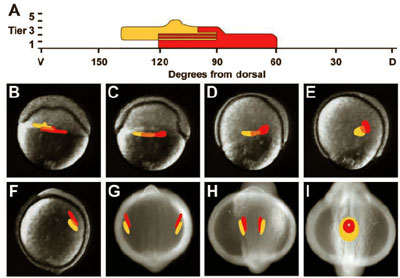CARDIAC CHAMBER PROGENITOR FATE MAP
![]()
![]()
The embryonic vertebrate heart is organized into two major chambers, the ventricle and atrium, each consisting of two tissue layers, the myocardium and endocardium. To test models of cardiac chamber specification, we generated a high-resolution fate map of cardiac chamber progenitors in the zebrafish embryo at 40% epiboly, a stage prior to the initiation of gastrulation. Our map reveals a distinct spatial organization of myocardial progenitors: ventricular myocardial progenitors are positioned closer to the margin and to the dorsal midline than are atrial myocardial progenitors. By contrast, ventricular and atrial endocardial progenitors are not spatially organized at this stage. The relative orientations of ventricular and atrial myocardial progenitors before and after gastrulation suggest orderly movements of these populations. Furthermore, the initial positions of myocardial progenitors at 40% epiboly indicate that signals residing at the embryonic margin could influence chamber fate assignment. Indeed, via fate mapping, we demonstrate that Nodal signaling promotes ventricular fate specification near the margin, thereby playing an important early role during myocardial patterning.
 |